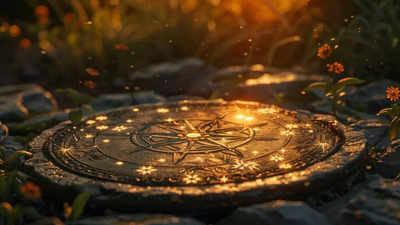
exist vedic astrologyan ancient system derived from the Indian subcontinent, the twelve signs of the human zodiac, or Rashiis determined based on the exact time, date and place of birth. Unlike Western astrology which mainly focuses on the position of the Sun, Vedic astrology mainly focuses on the position of the Moon at the time of birth. This unique method is believed to provide a deeper understanding of a person’s emotional, psychological and spiritual nature.
1. Role of Moon in Determining Raashi
this moon signalso known as birth amountis the cornerstone of Vedic astrology. It is determined by the sign or zodiac sign in which the moon is located at the time of birth. As the Moon moves rapidly through the zodiac (staying in each sign for approximately 2.5 days), it has a profound impact on a person’s emotions, instincts, and inner self. Astrologers use moon signs to gain insight into a person’s subconscious, emotional tendencies, and overall life trajectory.
2. Rising sign: the first house of the sign
Ascendant, or Ragnaris the constellation rising on the eastern horizon at birth. It represents the starting point of an astrological chart and is related to a person’s outer personality, physical characteristics and overall lifestyle. The Ascendant changes approximately every two hours, making the time of birth crucial for determining a specific birth time Ragnar Symbols and diagram structures. The rising sign and the moon sign together form the basis of a person’s identity and behavior.
3. The twelve zodiac signs and their influence
In Vedic astrology, there are twelve zodiac signs, each ruled by a specific planet and possessing different qualities. These signs are divided into four elements—fire, earth, air, and water—that shape personality traits and preferences:
- Aries (Misha): Ruled by Mars, associated with action and leadership.
- Taurus (Virishaba): Ruled by Venus, associated with material comfort and stability.
- Gemini (Misuna): Ruled by Mercury, known for adaptability and intelligence.
- cancer: Ruled by the moon, it represents emotions and family relationships.
- Leo(Sinha): Ruled by the Sun, embodies confidence and creativity.
- Virgo(her): Ruled by Mercury, attention to detail and service.
- Libra (Tula): Ruled by Venus, centered on balance and harmony.
- Scorpio (Vrischika): Governed by Mars and Ketu, represents transformation.
- Sagittarius (Danu): Ruled by Jupiter, symbolizing adventure and wisdom.
- Capricorn (Makara): Ruled by Saturn, emphasizes discipline and ambition.
- Aquarius (Kamba): Ruled by Saturn and Rahu, aligned with innovation and humanity.
- Pisces (Mina): Ruled by Jupiter, associated with spirituality and compassion.
4. Nakshatras: Moon Palace
In addition to the twelve zodiac signs, Vedic astrology also contains 27 Nakshatras (moon houses). Each Nakshatra covers a 13 degree portion of the moon’s orbit and adds meticulous details to the Raashi. The nakshatra in which the Moon is positioned at birth can reveal specific characteristics, life path tendencies and karmic influences, helping astrologers create a highly personal interpretation of a birth chart.
5. Calculation of Birth Chart (kundali)
To determine a person’s Raashi and overall horoscope, Vedic astrologers make precise calculations based on the individual’s date, time and place of birth. These details are used to create the Kundali or natal chart, which is a map showing the positions of the planets in the 12 houses and Raashis. Each house represents a different aspect of life, such as career, relationships, health, and spirituality.
6. How does Vedic astrology differ from Western astrology?
While Western astrology is sun-centered and emphasizes the sun sign as a reflection of the core personality, Vedic astrology focuses on the moon sign and ascendant, providing a comprehensive picture of a person’s inner and outer world. Furthermore, Vedic astrology is based on the sidereal zodiac, which accounts for the precession of the equinoxes, unlike the tropical zodiac used in Western astrology.
Determine the meaning of Raashi at birth
Raashi is the soul’s blueprint, guiding a person’s journey through life and providing insight into their strengths, challenges, and goals. Vedic Astrology believes that understanding one’s Rakhi and planetary influences can bring clarity to life choices, provide solutions to obstacles, and support personal growth through alignment with one’s unique cosmic design.
By examining the Rakhi at birth, Vedic Astrology provides each individual with a structured and deeply personal understanding to help them navigate their destiny and realize their full potential.
!(function(f, b, e, v, n, t, s) { function loadFBEvents(isFBCampaignActive) { if (!isFBCampaignActive) { return; } (function(f, b, e, v, n, t, s) { if (f.fbq) return; n = f.fbq = function() { n.callMethod ? n.callMethod(...arguments) : n.queue.push(arguments); }; if (!f._fbq) f._fbq = n; n.push = n; n.loaded = !0; n.version = '2.0'; n.queue = (); t = b.createElement(e); t.async = !0; t.defer = !0; t.src = v; s = b.getElementsByTagName(e)(0); s.parentNode.insertBefore(t, s); })(f, b, e, 'https://connect.facebook.net/en_US/fbevents.js', n, t, s); fbq('init', '593671331875494'); fbq('track', 'PageView'); };
function loadGtagEvents(isGoogleCampaignActive) { if (!isGoogleCampaignActive) { return; } var id = document.getElementById('toi-plus-google-campaign'); if (id) { return; } (function(f, b, e, v, n, t, s) { t = b.createElement(e); t.async = !0; t.defer = !0; t.src = v; t.id = 'toi-plus-google-campaign'; s = b.getElementsByTagName(e)(0); s.parentNode.insertBefore(t, s); })(f, b, e, 'https://www.googletagmanager.com/gtag/js?id=AW-877820074', n, t, s); };
function loadSurvicateJs(allowedSurvicateSections = ()){ const section = window.location.pathname.split('/')(1) const isHomePageAllowed = window.location.pathname === '/' && allowedSurvicateSections.includes('homepage')
if(allowedSurvicateSections.includes(section) || isHomePageAllowed){ (function(w) {
function setAttributes() { var prime_user_status = window.isPrime ? 'paid' : 'free' ; w._sva.setVisitorTraits({ toi_user_subscription_status : prime_user_status }); }
if (w._sva && w._sva.setVisitorTraits) { setAttributes(); } else { w.addEventListener("SurvicateReady", setAttributes); }
var s = document.createElement('script'); s.src="https://survey.survicate.com/workspaces/0be6ae9845d14a7c8ff08a7a00bd9b21/web_surveys.js"; s.async = true; var e = document.getElementsByTagName('script')(0); e.parentNode.insertBefore(s, e); })(window); }
}
window.TimesApps = window.TimesApps || {}; var TimesApps = window.TimesApps; TimesApps.toiPlusEvents = function(config) { var isConfigAvailable = "toiplus_site_settings" in f && "isFBCampaignActive" in f.toiplus_site_settings && "isGoogleCampaignActive" in f.toiplus_site_settings; var isPrimeUser = window.isPrime; var isPrimeUserLayout = window.isPrimeUserLayout; if (isConfigAvailable && !isPrimeUser) { loadGtagEvents(f.toiplus_site_settings.isGoogleCampaignActive); loadFBEvents(f.toiplus_site_settings.isFBCampaignActive); loadSurvicateJs(f.toiplus_site_settings.allowedSurvicateSections); } else { var JarvisUrl="https://jarvis.indiatimes.com/v1/feeds/toi_plus/site_settings/643526e21443833f0c454615?db_env=published"; window.getFromClient(JarvisUrl, function(config){ if (config) { const allowedSectionSuricate = (isPrimeUserLayout) ? config?.allowedSurvicatePrimeSections : config?.allowedSurvicateSections loadGtagEvents(config?.isGoogleCampaignActive); loadFBEvents(config?.isFBCampaignActive); loadSurvicateJs(allowedSectionSuricate); } }) } }; })( window, document, 'script', );







